The Conversation
July 27, 2023

The Universe
When theoretical physicists like myself say that we’re studying why the universe exists, we sound like philosophers. But new data collected by researchers using Japan’s Subaru telescope has revealed insights into that very question.
The Big Bangkick-started the universe as we know it 13.8 billion years ago. Many theories in particle physics suggest that for all the matter created at the universe’s conception, an equal amount of antimatter should have been created alongside it. Antimatter, like matter, has mass and takes up space. However, antimatter particles exhibit the opposite properties of their corresponding matter particles.
When pieces of matter and antimatter collide, they annihilate each other in a powerful explosion, leaving behind only energy. The puzzling thing about theories that predict the creation of an equal balance of matter and antimatter is that if they were true, the two would have totally annihilated each other, leaving the universe empty. So there must have been more matter than antimatter at the birth of the universe, because the universe isn’t empty – it’s full of stuff that’s made of matter like galaxies, stars and planets. A little bit of antimatter exists around us, but it is very rare.
As a physicist working on Subaru data, I’m interested in this so-called matter-antimatter asymmetry problem. In our recent study, my collaborators and I found that the telescope’s new measurement of the amount and type of helium in faraway galaxies may offer a solution to this long-standing mystery.
After the Big Bang
In the first milliseconds after the Big Bang, the universe was hot, dense and full of elementary particles like protons, neutrons and electrons swimming around in a plasma. Also present in this pool of particles were neutrinos, which are very tiny, weakly interacting particles, and antineutrinos, their antimatter counterparts.
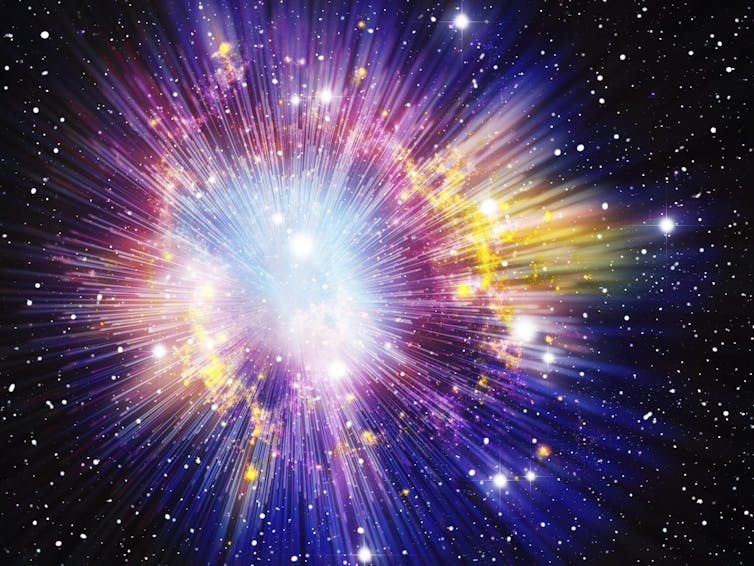
The Big Bang created fundamental particles that make up other particles like protons and neutrons. Neutrinos are another type of fundamental particle.
Physicists believe that just one second after the Big Bang, the nuclei of light elements like hydrogen and helium began to form. This process is known as Big Bang Nucleosynthesis. The nuclei formed were about 75% hydrogen nuclei and 24% helium nuclei, plus small amounts of heavier nuclei.
The physics community’s most widely accepted theory on the formation of these nuclei tells us that neutrinos and antineutrinos played a fundamental role in the creation of, in particular, helium nuclei.
Helium creation in the early universe happened in a two-step process. First, neutrons and protons converted from one to the other in a series of processes involving neutrinos and antineutrinos. As the universe cooled, these processes stopped and the ratio of protons to neutrons was set.
As theoretical physicists, we can create models to test how the ratio of protons to neutrons depends on the relative number of neutrinos and antineutrinos in the early universe. If more neutrinos were present, then our models show more protons and fewer neutrons would exist as a result.
As the universe cooled, hydrogen, helium and other elements formed from these protons and neutrons. Helium is made up of two protons and two neutrons, and hydrogen is just one proton and no neutrons. So the fewer the neutrons available in the early universe, the less helium would be produced.
Because the nuclei formed during Big Bang Nucleosynthesis can still be observed today, scientists can infer how many neutrinos and antineutrinos were present during the early universe. They do this by looking specifically at galaxies that are rich in light elements like hydrogen and helium.
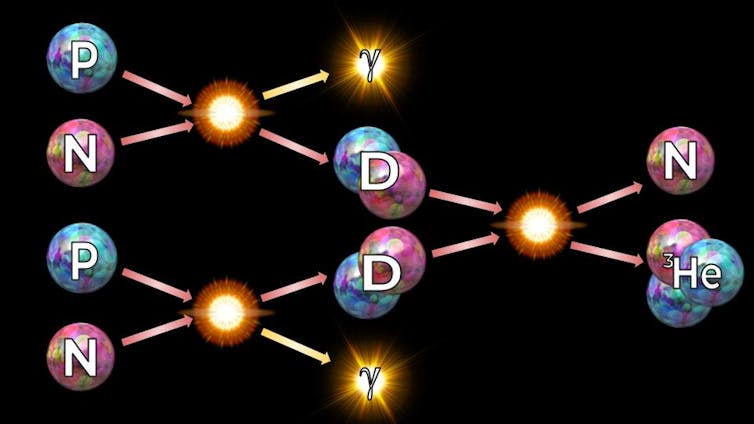
In a series of high-energy particle collisions, elements like helium are formed in the early universe. Here, D stands for deuterium, an isotope of hydrogen with one proton and one neutron, and γ stands for photons, or light particles. In the series of chain reactions shown, protons and neutrons fuse to form deuterium, then these deuterium nuclei fuse to form helium nuclei.
A clue in helium
Last year, the Subaru Collaboration – a group of Japanese scientists working on the Subaru telescope – released data on 10 galaxies far outside of our own that are almost exclusively made up of hydrogen and helium.
Using a technique that allows researchers to distinguish different elements from one another based on the wavelengths of light observed in the telescope, the Subaru scientists determined exactly how much helium exists in each of these 10 galaxies. Importantly, they found less helium than the previously accepted theory predicted.
With this new result, my collaborators and I worked backward to find the number of neutrinos and antineutrinos necessary to produce the helium abundance found in the data. Think back to your ninth grade math class when you were asked to solve for “X” in an equation. What my team did was essentially the more sophisticated version of that, where our “X” was the number of neutrinos or antineutrinos.
The previously accepted theory predicted that there should be the same number of neutrinos and antineutrinos in the early universe. However, when we tweaked this theory to give us a prediction that matched the new data set, we found that the number of neutrinos was greater than the number of antineutrinos.
What does it all mean?
This analysis of new helium-rich galaxy data has a far-reaching consequence – it can be used to explain the asymmetry between matter and antimatter. The Subaru data points us directly to a source for that imbalance: neutrinos. In this study, my collaborators and I proved that this new measurement of helium is consistent with there being more neutrinos then antineutrinos in the early universe. Through known and likely particle physics processes, the asymmetry in the neutrinos could propagate into an asymmetry in all matter.
The result of our study is a common type of result in the theoretical physics world. Basically, we discovered a viable way in which the matter-antimatter asymmetry could have been produced, but that doesn’t mean it definitely was produced in that way. The fact that the data fits with our theory is a hint that the theory we’ve proposed might be the correct one, but this fact alone doesn’t mean that it is.
So, are these tiny little neutrinos the key to answering the age old question, “Why does anything exist?” According to this new research, they just might be.

Anne-Katherine Burns, Ph.D. Candidate in Theoretical Particle Physics, University of California, Irvine
This article is republished from The Conversation under a Creative Commons license. Read the original article.
New analysis of SuperCDMS data sets tighter detection limits for dark matter
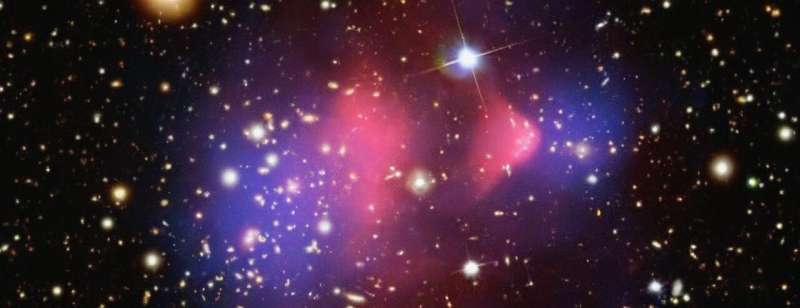
For nearly a century, dark matter has continued to evade direct detection, pushing scientists to come up with even more creative methods of searching. Increasingly sensitive detection experiments are a major undertaking, however, which means scientists want to be sure they analyze data from these experiments in the most thorough and robust way possible.
With that in mind, the Super Cryogenic Dark Matter Search (SuperCDMS) collaboration has published a reanalysis of previously published experimental data. Their study, published recently in Physical Review D, describes the team's search for dark matter via two processes called Bremsstrahlung radiation and the Migdal effect.
In a first-of-its-kind analysis, the team also worked with geologists to consider how the Earth's atmosphere and inner composition interact with dark matter particles to cause their energy to dissipate. The analysis represents one of the tightest limits on dark matter detection yet and sets the stage for future dark matter searches.
"As we search for dark matter, we need to extend detection sensitivities," said Noah Kurinksy, a staff scientist at SLAC and corresponding author on the study. "Having better ways to model these processes and understand these sorts of measurements is very important for the dark matter community."
Invisible scattering
In an experiment like SuperCDMS, physicists look for signs that dark matter has collided with the atomic nuclei—the protons and neutrons—inside a material such as silicon and germanium.
Usually, the assumption is that when a dark matter particle whacks into a nucleus, the collision is elastic: Any energy the dark matter particle loses is transferred into the motion of the nucleus, so that both particles recoil. "Your typical billiard balls scattering example," Kurinsky explained.
In recent years, however, researchers have proposed that dark matter may be detected through inelastic collisions, in which the energy from the collision is transferred to something else that's possibly easier to detect, such as photons or electrons. This could lead to more sensitive detection capabilities for dark matter detection experiments.
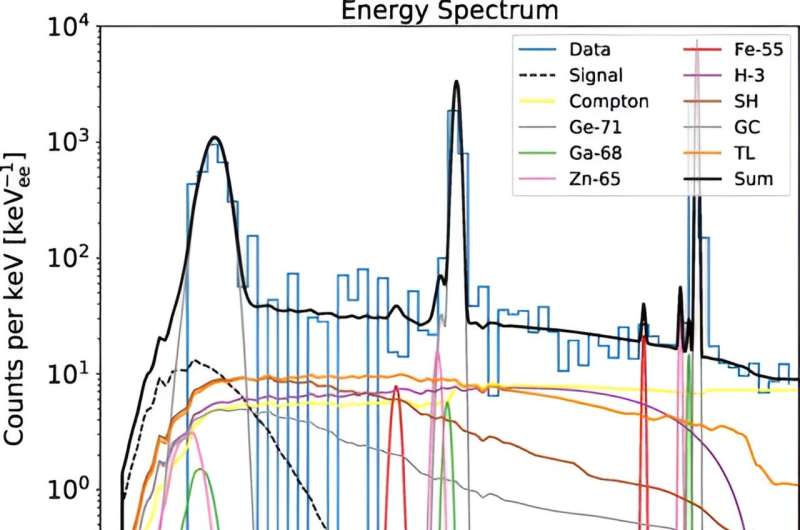
Considering that the SuperCDMS experiment is already one of the most sensitive dark matter detectors of its kind, "we wanted to know what the probability was that we see this particular type of signal in SuperCDMS data," said Daniel Jardin, a co-author of the new study and a postdoctoral scholar at Northwestern University who helped lead the analysis.
The team focused on two potential avenues for inelastic collisions to occur: Bremsstrahlung radiation and the Migdal effect.
Bremsstrahlung is a well-known and previously observed phenomenon caused by the deceleration of a charged particle—the word is German for "braking radiation." In a dark matter detector, this could happen when a dark matter particle collides with a nucleus, which then transfers some of its energy to a photon instead of just recoiling. If detected, that photon would suggest some mysterious, fast-moving particle—perhaps dark matter—slammed into the nucleus and sent the photon flying.
Another possible mode for inelastic collisions is through the Migdal effect. Although it has yet to be experimentally demonstrated, the idea is that when a dark matter particle strikes a nucleus, that nucleus gets knocked out of the center of its electron cloud. After some very short amount of time, the electron cloud readjusts around the nucleus, ejecting electrons that researchers could detect. In recent years, scientists have calculated what such a signal would look like should it happen within dark matter detectors.
Reanalyzing the data taking inelastic processes into account didn't reveal evidence of dark matter, Jardin said, but "each of these analyses extended the experiment's existing limits to lower masses." A previous SuperCDMS data analysis ruled out dark matter particles with masses as low as that of the proton. Taking Bremsstrahlung into account, the experiment can now rule out dark matter particle masses down to about a fifth of the proton mass—and even lower masses when the hypothetical Migdal effect is considered.
When Earth gets in the way
But the researchers didn't stop there. "We wanted to innovate beyond taking these ideas and applying it to our data," said Jardin. "So, we added other things that no one else has been doing."
Jardin and his colleagues not only extended the lowest limits of detection for dark matter interactions, but also considered the upper limit. "Researchers in the field are now realizing that if dark matter interacts strongly enough, it could interact with the atmosphere and the Earth on its way to the detector, which is deep underground. In that interaction there's actually an upper limit where you'd be blocked by the Earth itself," Jardin said.
In particular, the more strongly dark matter interacts with other types of matter on its way to the detector, the more energy it loses. At some point, a dark matter particle could lose so much energy that by the time it reaches the detector it can no longer create a detectable signal.
To calculate the energy limit for dark matter particles reaching the SuperCDMS experiment, the researchers modeled how the densities of Earth's atmosphere and inner layers might affect a dark matter particle pummeling through our planet to the detector. The team worked with geologists who determined the exact composition of the soil and rock surrounding the detector in the Soudan Mine in Minnesota.
With this information, the team could set upper limits for dark matter interaction strength depending on where the particle would be coming from, whether that's directly above the detector or the other side of the Earth.
After analyzing the SuperCDMS data with the new models established by the Bremsstrahlung and Migdal effects and the new upper limits, the team was able to expand the range of particle masses the experiment was sensitive to but found no evidence of dark matter interactions. Nonetheless, the analysis represents one of the most sensitive search for ultralight dark matter and helped researchers gain more information from existing data.
"We put a lot into this experiment, so we want to get the most out of it that we can," Jardin said. "We really don't know the mass of dark matter, and we don't know how it interacts with matter. We're just reaching out into the darkness, as best we can."
More information: M. F. Albakry et al, Search for low-mass dark matter via bremsstrahlung radiation and the Migdal effect in SuperCDMS, Physical Review D (2023). DOI: 10.1103/PhysRevD.107.112013
Journal information: Physical Review D
Provided by SLAC National Accelerator Laboratory PandaX sets new constraints on the search for light dark matter via ionization signals
Astronomers shed new light on formation of mysterious fast radio bursts
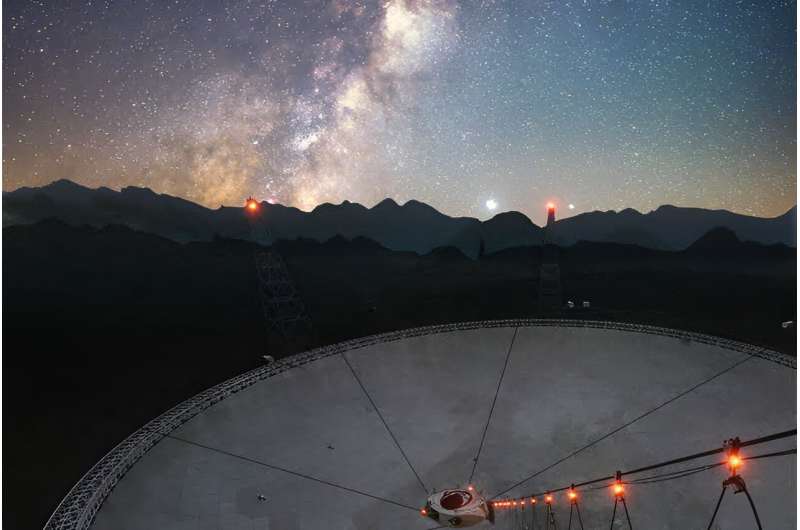
More than 15 years after the discovery of fast radio bursts (FRBs)—millisecond-long, deep-space cosmic explosions of electromagnetic radiation—astronomers worldwide have been combing the universe to uncover clues about how and why they form.
Nearly all FRBs identified have originated in deep space outside our Milky Way galaxy. That is until April 2020, when the first Galactic FRB, named FRB 20200428, was detected. This FRB was produced by a magnetar (SGR J1935+2154), a dense, city-sized neutron star with an incredibly powerful magnetic field.
This groundbreaking discovery led some to believe that FRBs identified at cosmological distances outside our galaxy may also be produced by magnetars. However, the smoking gun for such a scenario, a rotation period due to the spin of the magnetar, has so far escaped detection. New research into SGR J1935+2154 sheds light on this curious discrepancy.
In the July 28 issue of the journal Science Advances, an international team of scientists, including UNLV astrophysicist Bing Zhang, report on continued monitoring of SGR J1935+2154 following the April 2020 FRB, and the discovery of another cosmological phenomenon known as a radio pulsar phase five months later.
Unraveling a cosmological conundrum
To aid them in their quest for answers, astronomers rely in part on powerful radio telescopes like the massive Five-hundred-meter Aperture Spherical radio Telescope (FAST) in China to track FRBs and other deep-space activity. Using FAST, astronomers observed that FRB 20200428 and the later pulsar phase originated from different regions within the scope of the magnetar, which hints towards different origins.
"FAST detected 795 pulses in 16.5 hours over 13 days from the source," said Weiwei Zhu, lead author of the paper from National Astronomical Observatory of China (NAOC). "These pulses show different observational properties from the bursts observed from the source."
This dichotomy in emission modes from the region of a magnetosphere helps astronomers understand how—and where—FRBs and related phenomena occur within our galaxy and perhaps also those at further cosmological distances.
Radio pulses are cosmic electromagnetic explosions, similar to FRBs, but typically emit a brightness roughly 10 orders of magnitude less than an FRB. Pulses are typically observed not in magnetars but in other rotating neutron stars known as pulsars. According to Zhang, a corresponding author on the paper and director of the Nevada Center for Astrophysics, most magnetars do not emit radio pulses most of the time, probably due to their extremely strong magnetic fields. But, as was the case with SGR J1935+2154, some of them become temporary radio pulsars after some bursting activities.
Another trait that makes bursts and pulses different are their emission "phases", i.e. the time window where radio emission is emitted in each period of emission.
"Like pulses in radio pulsars, the magnetar pulses are emitted within a narrow phase window within the period," said Zhang. "This is the well-known 'lighthouse' effect, namely, the emission beam sweeps the line of sight once a period and only during a short interval in time in each period. One can then observe the pulsed radio emission."
Zhang said the April 2020 FRB, and several later, less energetic bursts were emitted in random phases not within the pulse window identified in the pulsar phase.
"This strongly suggests that pulses and bursts originate from different locations within the magnetar magnetosphere, suggesting possibly different emission mechanisms between pulses and bursts," he said.
Implications for cosmological FRBs
Such a detailed observation of a Galactic FRB source sheds light on the mysterious FRBs prevailing at cosmological distances.
Many sources of cosmological FRBs—those occurring outside our galaxy—have been observed to repeat. In some instances, FAST has detected thousands of repeated bursts from a few sources. Deep searches for seconds-level periodicity have been carried out using these bursts in the past and so far no period was discovered.
According to Zhang, this casts doubt on the popular idea that repeating FRBs are powered by magnetars in the past.
"Our discovery that bursts tend to be generated in random phases provides a natural interpretation to the non-detection of periodicity from repeating FRBs," he said. "For unknown reasons, bursts tend to be emitted in all directions from a magnetar, making it impossible to identify periods from FRB sources."
More information: Weiwei Zhu et al, A radio pulsar phase from SGR J1935+2154 provides clues to the magnetar FRB mechanism, Science Advances (2023). DOI: 10.1126/sciadv.adf6198
Journal information: Science Advances
Provided by University of Nevada, Las Vegas FAST helps reveal the origin of fast radio bursts
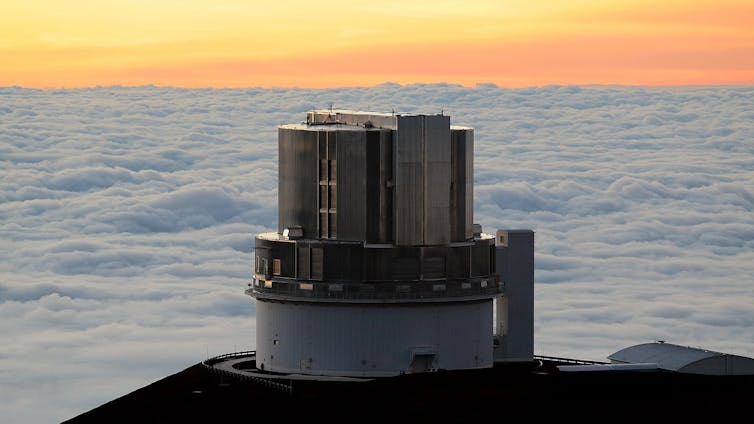
No comments:
Post a Comment